Types and varieties of heuchera
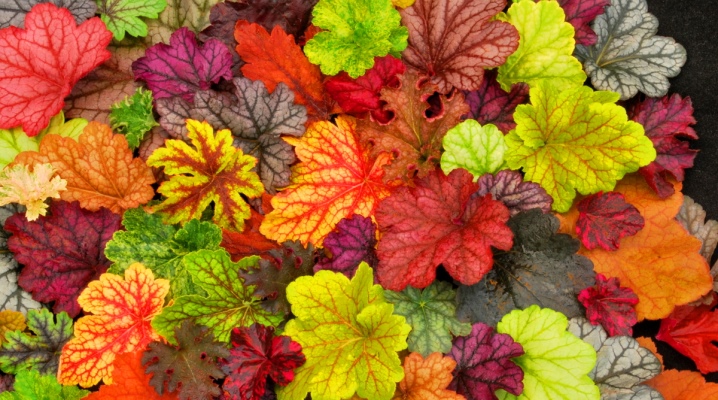
Geichera is one of the most popular perennial species in modern landscape design. The heuchera bush is small - only half a meter in height, but its leaves attract attention with their unusual and varied color palette. A feature of this American plant is that during its development, its leaves can change their color several times.
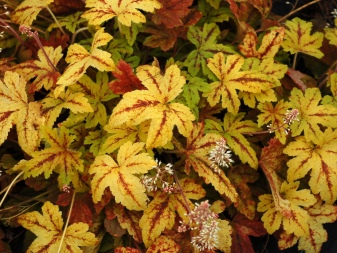
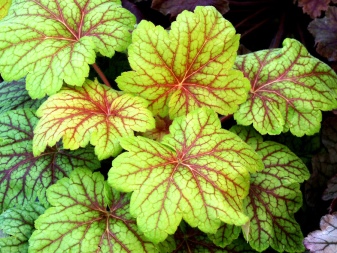
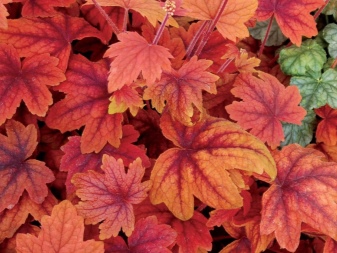

Popular types
Heuchera comes from North America, where she was not immediately noticed. A small shrub merged with the forest area. But due to its heart-shaped-rounded leaves, Heuchera attracted attention and became one of the cultivated plants. The varieties known to date were derived from three types of Heuchera: American, blood-red and hairy.
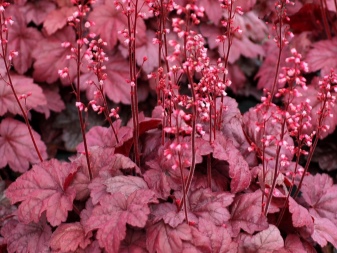
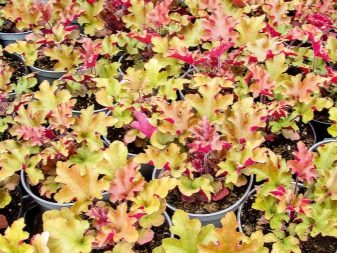
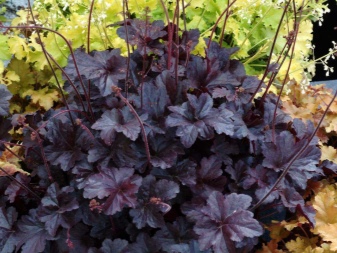
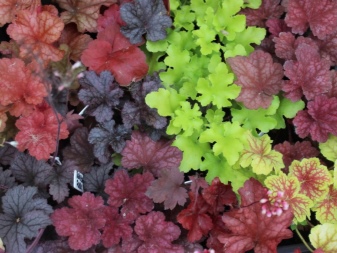
American
The flowering period is June-July, in autumn the leaves change their color and acquire a delicate brown color with silvery blotches and veins. Under certain conditions, crimson, red or coral edging appears on the leaves. In our climate, this is possible in late autumn. According to experts, this color is the plant's reaction to the approach of frost.
The plant can withstand up to -35 degrees, but in winter it is recommended to cover it, especially when young. Geichera loves loose, non-acidic soil, moderately moist and well fertilized with compost or humus. Plants with a closed root system, as well as very tiny specimens, take root well.
In heavy soil, the plant grows unattractive. After planting, the seedling must be well watered and shaded so that direct sunlight does not fall on it.
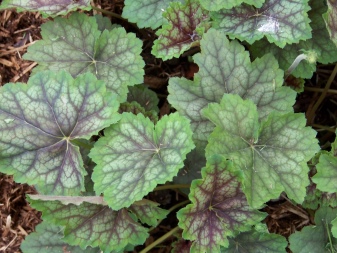
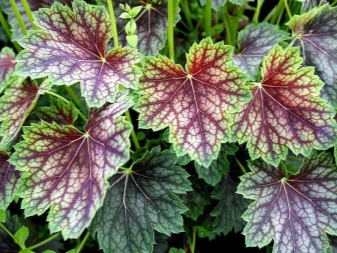

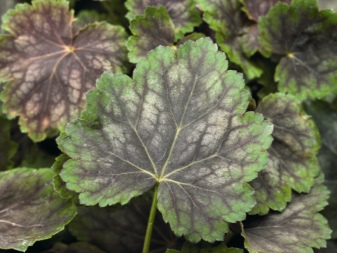
Blood red
This species is also called coral bell, as its buds have the same color and shape. It differs from other species in that the leaves grow on long, thin stems. The unusual appearance and color of this Heuchera was one of the first to be noticed. Among other differences of the blood-red heuchera, it can be noted that the plant loves moisture very much, does not tolerate drought. The plant retains its decorative properties until autumn, blooms in summer from July to August. This species is more resistant to frost than the American one, tolerates up to -40 degrees.
It grows quite quickly, so you need to plant the bush every 3-5 years.
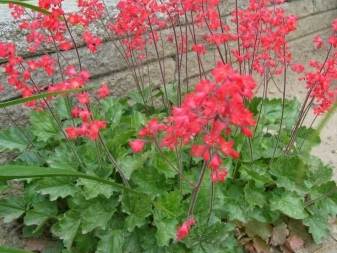
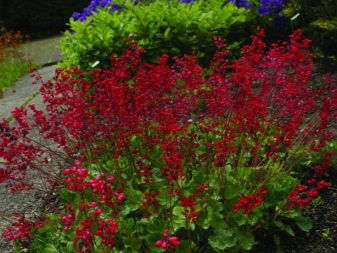
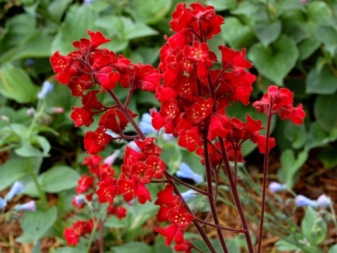
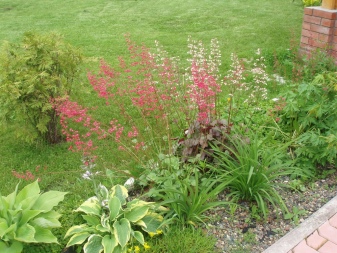
The plant does not like too acidic soil. These herbaceous plants are intended for open ground. For planting, it is better to choose a place that is not too lit. Ash and fertilizers should be put at the bottom of the pit, after which it is well watered. It is unpretentious in care - you just need to sometimes loosen the ground and carry out mulching. Also, there is no need to regularly feed the plant and cover in the winter.
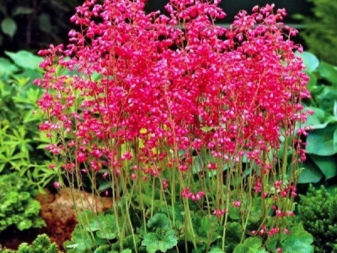

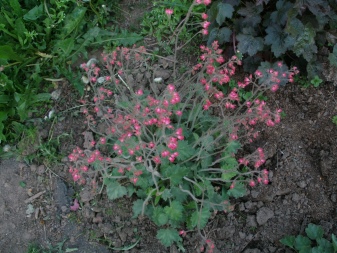
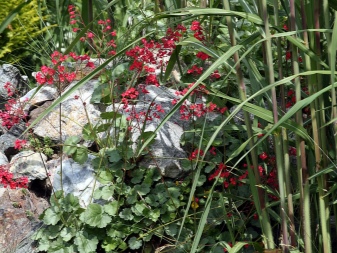
Small-flowered
In nature, it grows along the entire coast of the Atlantic Ocean in North America. This species is considered the most beautiful and sophisticated. The small-flowered Heuchera is not high, but the leaves are collected in a lush rosette (resemble the leaves of a Norway maple). The color of the leaves is unusual - with gray-silver blotches, they can be round or with denticles in shape. It was this feature that allowed breeders to develop varieties with multi-colored foliage, which look very impressive.
The flowering period is from May to June, the flowers are small and numerous, the height of the inflorescences can reach 60 cm. This species is very fastidious, loves fertilized soil, loose, well-moistened.
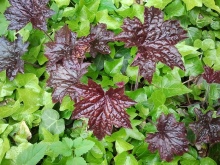
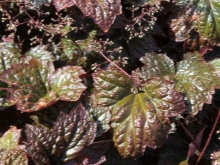
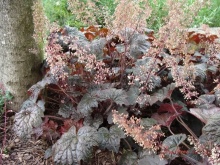
This species is the most unstable to frost, therefore it can often be found in the southern regions of Russia.There are also peculiarities in caring for it - the culture needs good drainage, loose and very moist soil, light, the plant needs to be regularly spud and loosened. Small-colored Heuchera does not like to be in the shade; diffused light suits her for good growth. Gardeners recommend replanting the plant every 3-4 years so that the rosette retains its beautiful appearance.
Heuchera quagmire is a garden hybrid with bright fluffy bells on tall inflorescences. From the moment they began to breed Heuchera at home, breeders have been developing more and more varieties, which are given incredible names for the color of their leaves - pink, coral, with colored veins, silver and others.
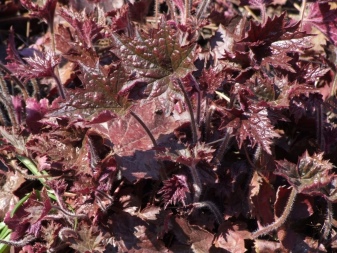
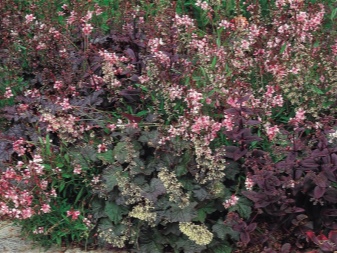
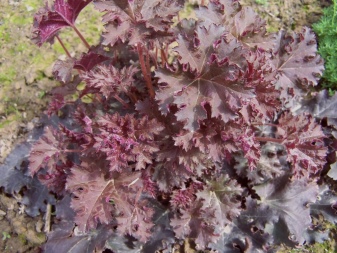
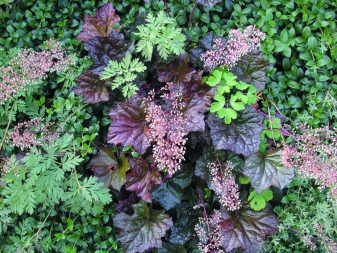
Popular varieties
Now there are a huge number of varieties of heuchera and blooming, and not blooming. The most popular varieties.
- Cherry cola - in this variety, the leaves have a rounded wavy shape, their color is orange-red, at the end of the season they acquire a yellowish-green hue. Cherry cola blooms with coral-red flowers in May-June, tolerates winter well. The shrub is low - up to 20 cm, loves partial shade, is unpretentious in care. The plant does not need frequent watering or feeding. If you make a full mineral dressing after flowering, the decorative properties will improve. Despite the good tolerance of low temperatures, it is recommended to cover the rosettes of leaves with dry leaves before frost. In spring, Cherry cola can suffer from a lack of water and sunburn, so it is best to monitor the moisture of the soil and shade the plant during this period.
Gardeners appreciate this variety for a long decorative period - from early spring to late autumn.

- "Obsidian" - This variety has the blackest flowers of all. The plant has dense, shiny, round leaves that do not change color throughout the season. This hybrid tolerates both sunlight and shade well. In June, it begins to bloom with small cream-colored flowers. Loves moderately moist soil, but excess moisture can cause disease of its root system. At the same time, the plant is completely unpretentious in care - it does not need anything other than watering. Once every 3-5 years, it needs to be seated. In obsidian, dry leaves should be removed only in spring, and in winter, a bush with leaves is covered with sawdust or peat.
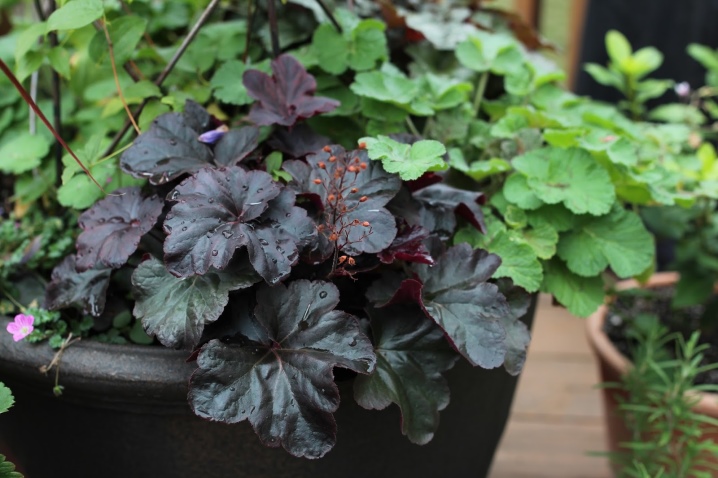
- Apple crisp - this variety has emerald leaves with silvery blotches, in appearance they resemble corrugation. This variety of Heuchera blooms with small white flowers in the form of bells in June-July. The shrub tolerates both sun and shade well, loves fertilizers.
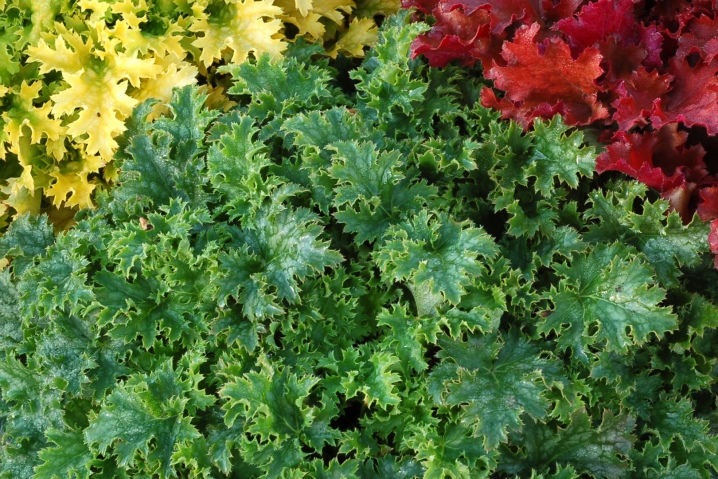
- "Caramel" - a low shrub up to 30 cm high, has the shape of a dome with large beautiful leaves of a golden copper color. The first spring leaves are reddish, but closer to summer their color becomes golden, and by autumn the colors become more intense. Flowering begins in June-July, flowers are small, pleasant pink color. It is the caramel-colored leaves that represent the value of the variety. Now there is a new variety "Mega Caramel", which grows up to 50 cm, its leaves and flowers are 2 times larger than those of the usual variety.
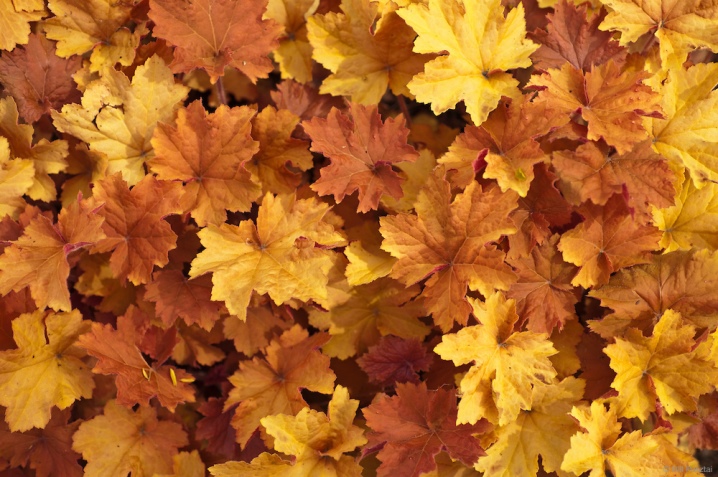
- "Electra" - a rather large bush, reaches a height of 40 cm. Leaves of bright yellow color with red veins are collected in a lush rosette. In summer, the leaves change color to greenish-yellow, but red streaks remain on them throughout the season. Blooms in May-June. This unusual variety prefers light shade from trees, but thrives in full shade. Loves light soil with moderate moisture. There is no particular need for feeding, but in the spring it can suffer from a lack of moisture and sunburn. It is not necessary to cut off the leaves before wintering, but it is better to cover young shrubs before frosts with fallen leaves. Gardeners recommend planting such a bush every 3-4 years.
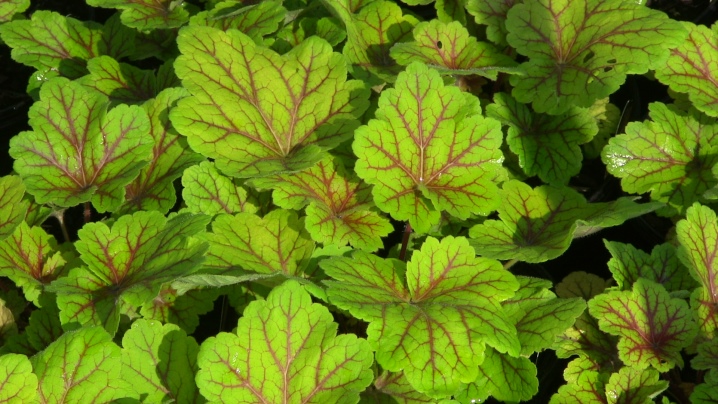
- "Midnight Rose" - the variety is distinguished by leaves of a rich burgundy color with pinkish blotches.Pink spots appear in spring, over time, their color becomes more and more saturated. It can reach a height of 40 cm, in late spring it begins to bloom. This variety tolerates direct sunlight and partial shade well.
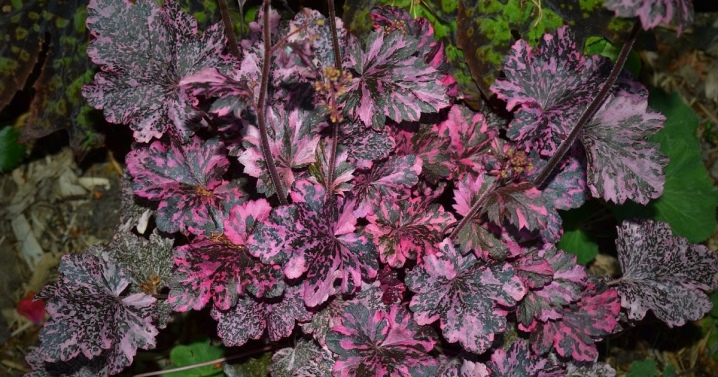
- "Tiramisu" - this variety changes color as many as three times per season. The first spring leaves have yellow edges and a dark red veined middle, in summer they become smoky silver, and by the end of the season change their color to dark red with yellow edges. In mid-July, small creamy yellow flowers appear, which remain until September. The height of the shrub is only 25 cm, so gardeners love to plant this variety in flowerpots and containers. The bush tolerates sunny and semi-dark places well, does not like wind and stagnant moisture. He does not need frequent feeding. Before wintering, you need to leave the dried leaves, cut them off in early spring.
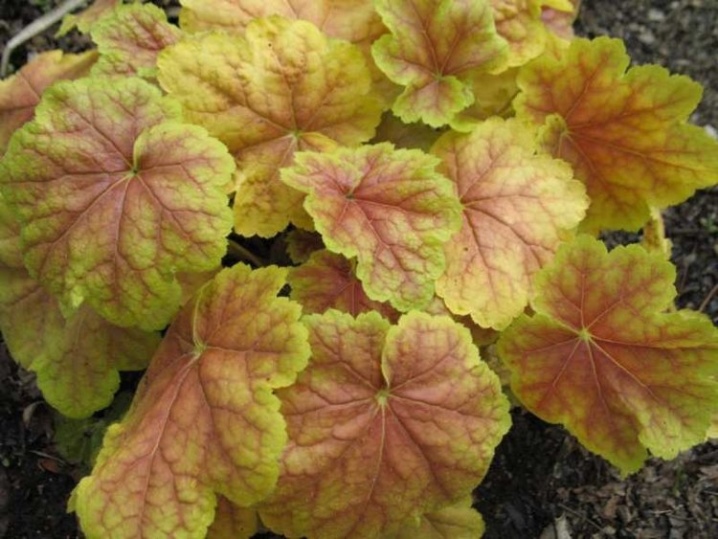
- "Paprika" - the crop has large wavy leaves that change color as it grows. Young leaves are red-orange, then they become rich cherry. The leaves have white streaks, which looks especially interesting against the bright red background. Shrub up to 20 cm high, flowering begins in May-June. This variety prefers cool places with light shade.
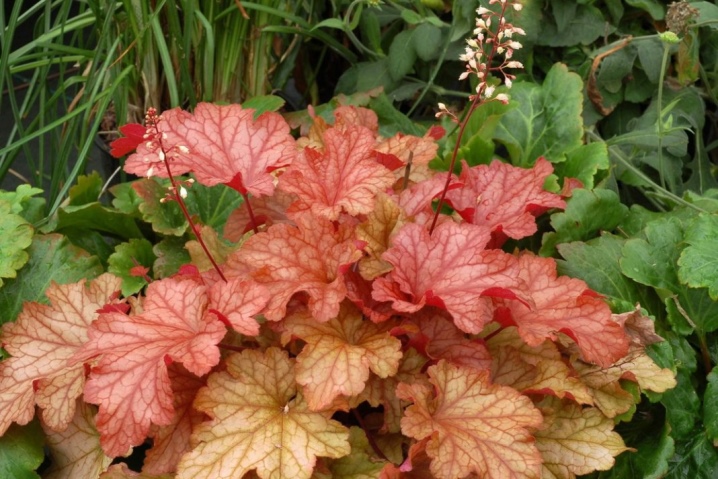
- "Rio" - a new hybrid, the leaves of which change their color throughout the season, from pale green to deep red. This variety has a long flowering - from May to September. The bush is low - up to 20 cm, loves the sun and partial shade, prefers moist soil and fertilizers.
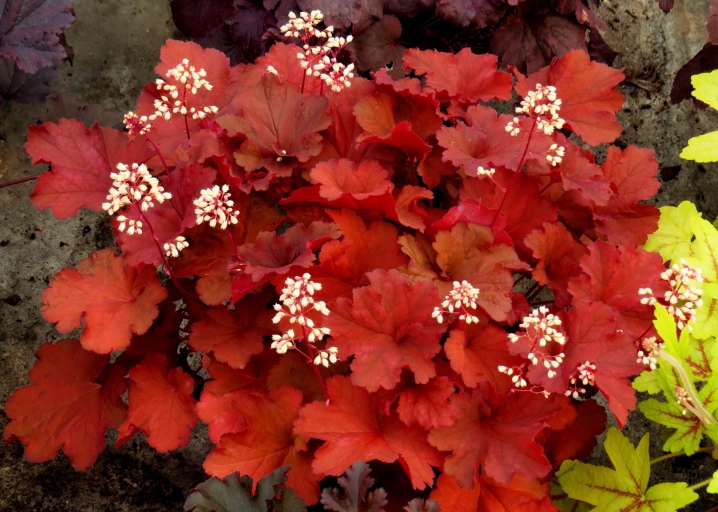
- "Purple Castle" - the leaves of this variety are ivy-shaped, red-purple in color, especially rich color on the lower part of the leaves. The upper part of the leaf can change shade several times per season. Some leaves have black streaks, others are almost black in color. It blooms with small bell-shaped flowers from June to August, their color may change depending on the lighting. The shrub reaches a height of 50 cm. Like all dark geychera, it prefers shaded areas, moderate humidity and fertilizers.

- Forever Purple - a variety that has a spherical shape, reaches a height of 30 cm. The color of the leaves is rare - bright purple with dark veins, the shape is complex, the edges are carved. In the second half of summer, the bush begins to bloom. The plant grows well in partial shade, loves moist soil without moisture stagnation. Before wintering, you need to sprinkle the plant with fallen leaves.

- Berry smoothie - one of the brightest varieties. Its leaves change color from bright pink to purple-violet during the season. The bush is large and neat at the same time, it grows up to 30 cm in height. Large leaves have large veins. The inflorescences are high - up to 55 cm, beige small flowers bloom on them from May to September. This variety loves partial shade, in the open sun it will need to be watered more often. Prefers soil without stagnant moisture and fertilization. The variety is resistant to diseases, withstands frosts well, before wintering, you only need to mulch the root part.
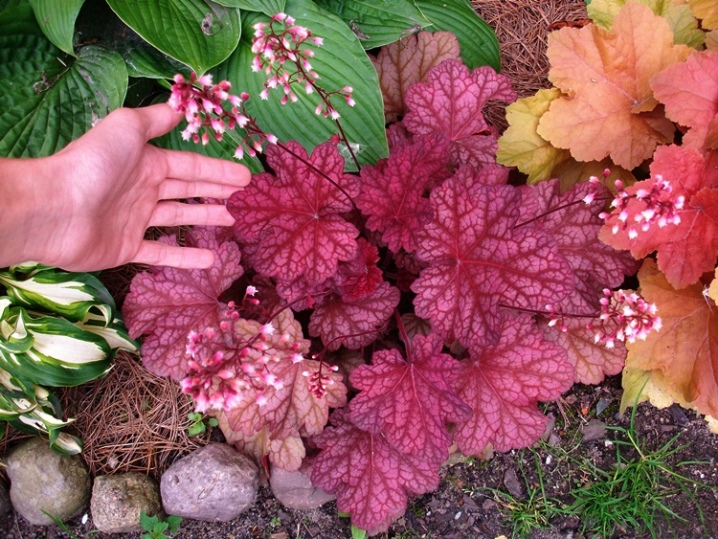
- "Shanghai" - variety with silvery purple leaves with dark veins. Flowering can last more than two months. Pink, coral, red flowers appear on dark inflorescences. Heavy rain and wind can lay the inflorescences. This variety loves well-fertilized soil without stagnant water. Prefers to be in partial shade.
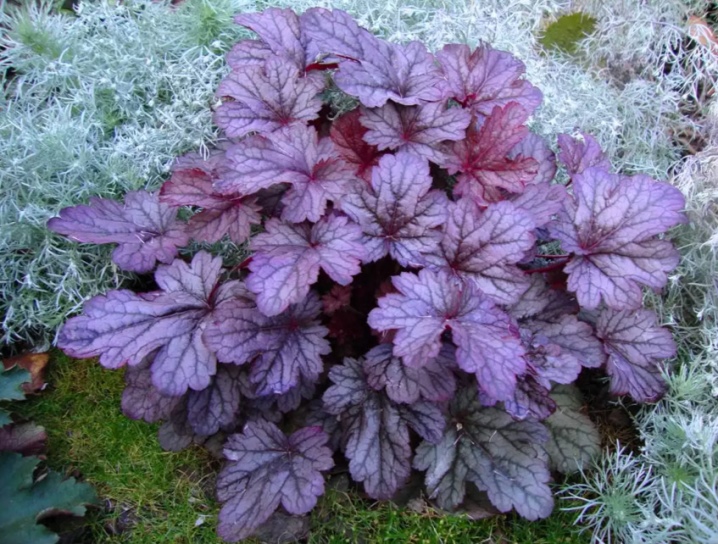
- "Beaujolais" - the variety is large and hardy, the leaves are velvety, wine-colored, with a smooth transition to dark cherry. During the flowering period, small pink flowers appear on large inflorescences. The variety grows well in partial shade. The leaves lose their color in the sun.

- "Milan" - this variety takes on a spherical shape. Leaves are silvery, pink flowers appear during the flowering period (from May to September). The leaves are not large in size, they have burgundy veins, the lower part of a more intense dark red color.In autumn, the leaves take on a burgundy hue. This variety, like many others, prefers partial shade. In the sun, the shrub will have to be watered more often; in full shade, the color of the leaves may darken. Loves fertilizers, is resistant to diseases, tolerates severe frosts well. Leaves are not cut off for the winter. The root part must be mulched. From spring to frost, the variety retains its decorative properties.
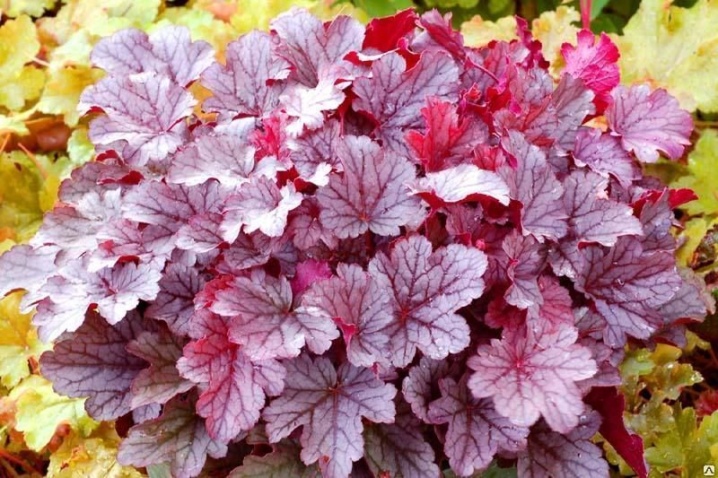
- Sugar Frosting - a spherical shrub up to 15 cm high, the leaves form a lush "cap", they are large, their color is silvery-plum with purple veins. In June-July, it begins to bloom with delicate creamy flowers. This variety prefers sunny or partial shade. The soil should be well fertilized and moist, but without stagnant water. The culture does not particularly need feeding. Before wintering, the leaves of the bush form a kind of shelter, so they do not need to be cut off. Can be mulched at the roots with sawdust or leaves.
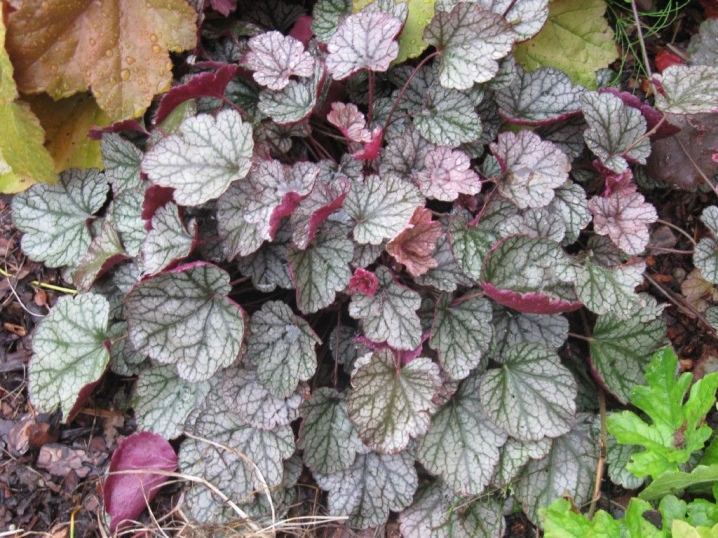
- "Palace purpl" - bush up to 3 cm high, spherical. The leaves are dark bronze above and purple-red below, large, resembling maple in shape, numerous inflorescences with small beige flowers. In dry weather, the leaves can turn bronze-green. Blooms in June-July. The variety prefers partial shade, moist soil without moisture stagnation. It is unpretentious in leaving, tolerates severe frosts well. This variety hibernates with live leaves that remain until the next season. Before frost, the roots need to be mulched and hilled.
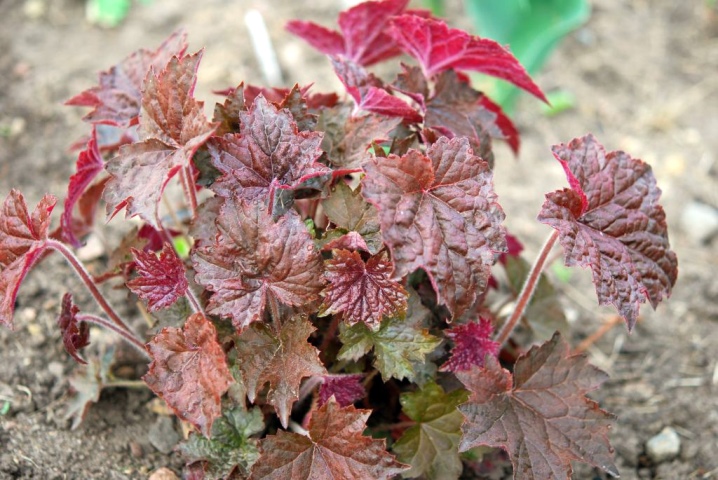
- "Black Taffeta" - a new variety with large shiny curly leaves. Their color is burgundy-chocolate, almost black. In June, pale pink flowers appear, which go well with dark leaves. This variety prefers shade, but grows well on the sunny side.
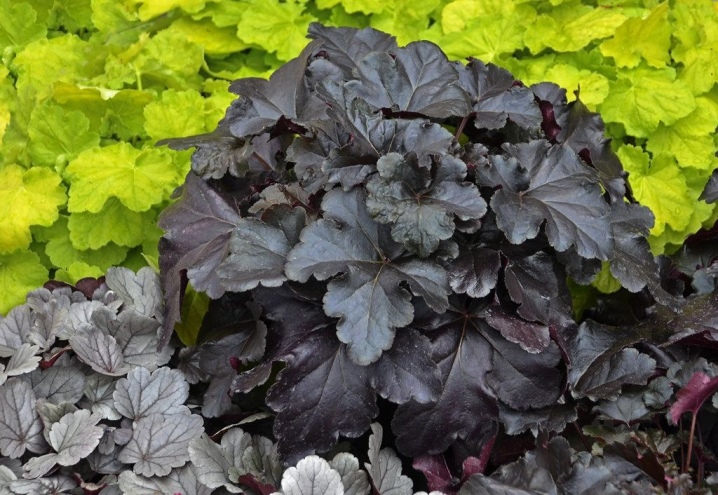
- "Zipper" - like other varieties of heuchera, the shrub is low (up to 30 cm). The leaves of this variety have an unusual color - from orange to golden with purple, besides, the back bright pink side is always in plain sight. The leaves are large, shiny and very bright. This variety blooms in May-June with delicate creamy white flowers, which look very impressive against the background of bright large leaves. Prefers partial shade, well-fertilized and moist soil without excess moisture. There is no need to feed him additionally. Leaves are left before wintering; it is recommended to cover the roots with a landscape cloth. Young shrubs mulch before frost and provide protection from the wind.

- Faroe Frost - a small neat shrub with bright leaves from yellow-green to lemon color, their center is burgundy, well expressed. In early summer, white flowers appear on tall inflorescences. This variety prefers partial shade, moist soil without excess water. In spring, it can suffer from lack of moisture and sunburn. A well-fortified bush can withstand severe frosts. Before wintering, the leaves are not cut off, but the rosette is mulched.
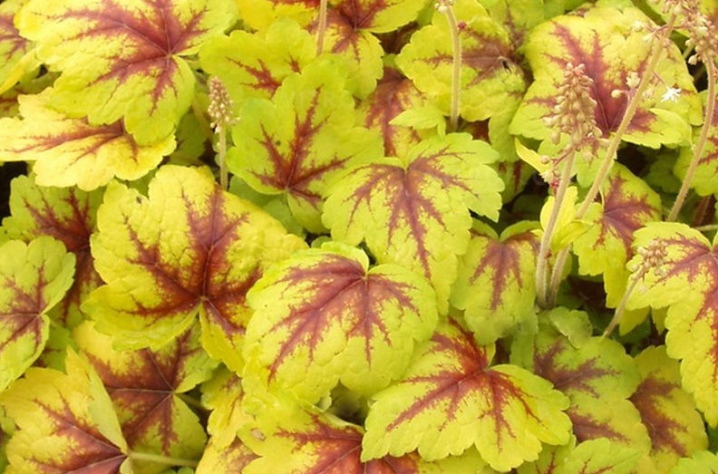
How to choose?
The properties of Heuchera have made it very popular in landscape design. This shrub has about half a thousand varieties, from which you can choose one or more plants to create an original composition on your site.
Heuchera is often chosen for decorating a flower garden with a small amount of vegetation. The shrub allows for a smooth transition during flowering from one type of flower to another. It retains its decorative properties all season - from spring to frost, and the bush can also retain its shape for several years. Therefore, these plants are often chosen for the decoration of borders, flower beds with a clear geometric shape. Another option for using Heuchera is the zoning of a personal plot.
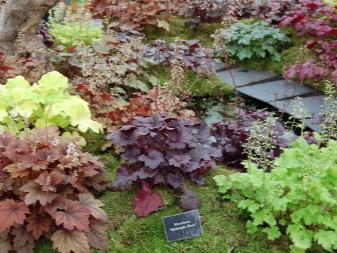
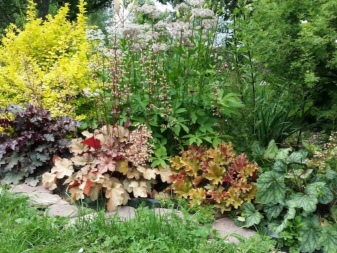
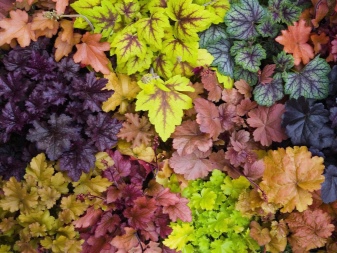
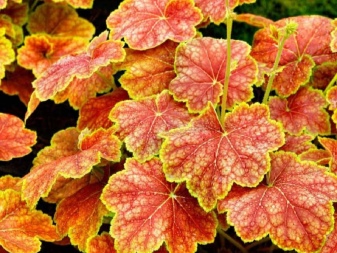
To choose a variety of Heuchera, you need to familiarize yourself with its description. All types are divided into mountain and forest.Blood-red heuchera belongs to the mountain species, all decorative varieties derived from it have dense, jagged leaves with veins. American Heuchera is a forest species - its leaves are rounded, resembling the shape of a heart.

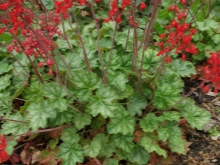
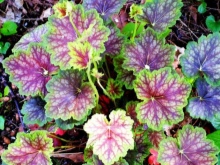
There is a cylindrical geychera, the name of which comes from the shape of the inflorescence. Hybrid Heuchera is the fruit of breeders. Crossing two or more species and subspecies made it possible to obtain a plant of various shapes, colors of leaves and flowers.
The most popular for a long time was considered to be the Palace Purple variety with large maroon leaves and creamy flowers, which are located on peduncles up to 50 cm high.
Several different varieties of geychera can be used to create a bright, unusual composition on your site. Also, these shrubs go well with other ornamental deciduous plants, fern, bruner, lungwort.
For care and types of heuchera, see the video below.







































































































The comment was sent successfully.